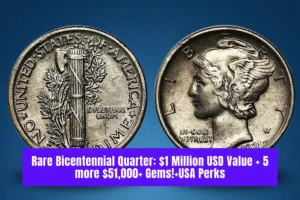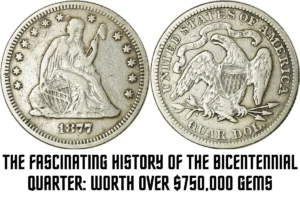The Bicentennial Quarter, a hallmark of American numismatic heritage, has remarkably surged past the $90 million mark, signaling a momentous milestone in the domain of coin collection.
Introduced in 1976 to commemorate two centuries of American independence, this quarter has evolved into a prized possession sought after by collectors and investors alike.
This listicle embarks on a journey to unpack the multifaceted elements contributing to its extraordinary value, shedding light on its historical backdrop, rarity, design prowess, and cultural resonance.
Historical Significance
Embedded within the fabric of American history, the Bicentennial Quarter holds profound significance.
Unveiled amidst the United States Bicentennial festivities, it serves as a tangible emblem of 200 years of independence and the nation’s rich tapestry of historical milestones.
As part of a series alongside the half dollar and dollar coins, each bearing distinct designs in homage to the occasion, its release encapsulated a pivotal moment in American narrative.
Collectors and historians cherish it not merely as a monetary artifact but as a conduit to America’s past, infusing it with enduring value.
Rarity and Minting Errors

The allure of the Bicentennial Quarter is further heightened by its scarcity, particularly in pristine conditions or adorned with minting anomalies.
While millions were minted, specimens in uncirculated states or featuring specific minting errors are exceedingly rare.
Error coins, showcasing double strikes, off-center motifs, or misprints, command significant attention from collectors, often fetching premium prices at auctions.
These exceptionalities serve as coveted treasures, enriching the coin’s allure and market value.
Exquisite Design
Crafted by Jack L. Ahr, the design of the Bicentennial Quarter stands as a testament to artistic brilliance.
Sporting a colonial drummer on the reverse, evoking the spirit of the American Revolutionary War, and adorned with a torch encircled by 13 stars on the obverse, it diverges from conventional imagery adorning U.S. currency.
This artistic ingenuity, coupled with symbolic resonance, elevates its appeal among collectors, bestowing upon it an esteemed position in numismatic circles.
Condition and Grading
The condition of the Bicentennial Quarter plays a pivotal role in determining its worth.
Coins graded by reputable agencies like the Professional Coin Grading Service (PCGS) or the Numismatic Guaranty Corporation (NGC) often command higher values.
A quarter in impeccable, uncirculated condition, boasting a premium grade, holds far greater worth than its face value.
Collectors and investors prioritize grading, as it underscores authenticity and quality, further enhancing the coin’s desirability.
Cultural Impact
The cultural resonance of the Bicentennial Quarter is immeasurable.
Embedded within the fabric of American culture, it serves as a poignant reminder of the nation’s journey and triumphs.
Its release amidst the Bicentennial celebrations rendered it more than just a coin; it became a cherished emblem of a national narrative, etching itself into the collective memory of millions.
This cultural cachet imparts an intangible value, rendering it indispensable to collectors drawn to coins not solely for their monetary worth but for their historical and cultural resonance.
Conclusion
The remarkable ascent of the Bicentennial Quarter beyond the $90 million threshold is a testament to its amalgamation of historical gravitas, rarity, design distinction, pristine condition, and cultural reverberation.
For collectors and enthusiasts alike, it transcends mere currency, embodying a tangible manifestation of American heritage and a prized asset in the realm of numismatics.
As time unfolds, its value, both monetarily and historically, is poised to appreciate further, ensuring its enduring status as a cherished treasure in the annals of coin collection.




